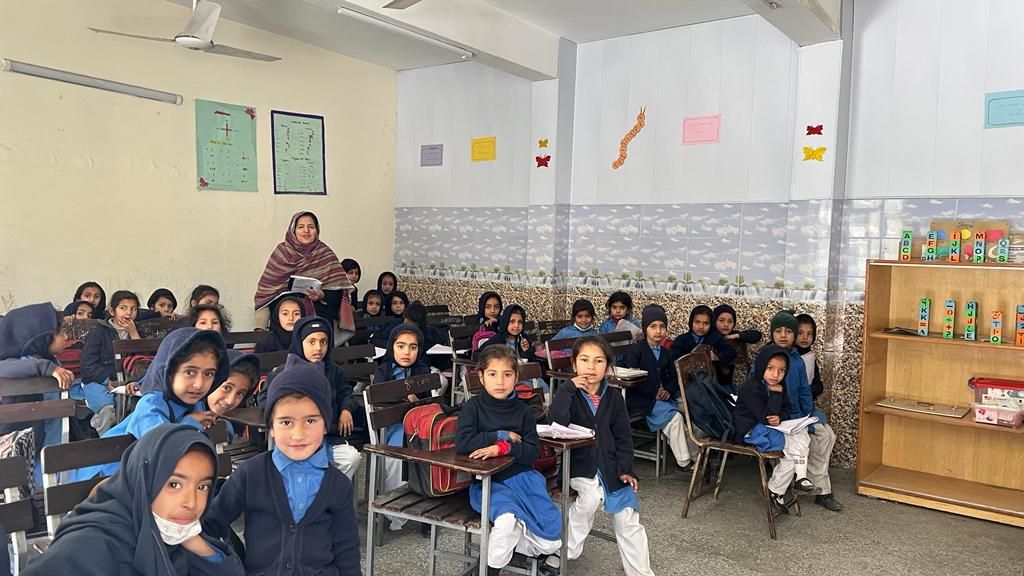
Gokina Smart Village in Pakistan: Digital transformation at the community level
By Atsuko Okuda, Director, ITU Regional Office for Asia and the Pacific
Gokina is an idyllic-looking village located 25 kilometers from Pakistan’s capital city. Our car ride there took us uphill on winding roads into the verdant mountains overlooking Islamabad. Goats greeted us as we walked down the steep, narrow path to the village school.
The village hosts a pilot Smart Villages project – the first Smart Village of the International Telecommunication Union (ITU) in the Asia-Pacific region. It is part of ITU’s Smart Villages and Smart Islands (SVSI) initiative, first launched in Niger in 2020 and subsequently adopted and adapted for Asia and the Pacific as a means of connecting unconnected people and communities by 2030.
Cosmas Luckyson Zavazava, Director of the ITU’s Telecommunication Development Bureau, has highlighted the key role of the initiative, emphasizing: “The strategy behind this is smart.”
Projects like the one in Gokina directly address key priorities set out during the World Telecommunication Development Conference (WTDC) last June in Kigali, Rwanda.
“It helps us implement the Kigali Action Plan, deliver tangible results for people, and make government services more accessible and financial inclusion possible,” Dr Zavazava adds. “Overall, it brings countries closer to meaningful connectivity and sustainable digital transformation.”
The Smart Villages initiative in Pakistan is supported by Huawei, ITU, the Federal Ministry of Information Technology and Telecommunication (MoITT), Universal Service Fund (USF Pakistan), social enterprise TeleTaleem, and one-stop telemedicine provider Sehat Kahani.
Pakistan’s Federal Minister of Information Technology and Telecommunication, H.E. Syed Amin Ul-Haque, launched the country-level initiative in Gokina earlier this year, on 23 February.
Local digital dividends
At the Islamabad Model School for Girls in Gokina, some students were learning online about global warming, while others were studying Urdu grammar.
Asked about the benefits of such e-learning, the girls all expressed excitement about connectivity and the expansion of their learning opportunities through the Smart Villages initiative.
Shaiza, a 9th Grade student at the school, said: “I am very happy to learn science subjects through the online classes that are now offered due to these smart classrooms. We never had this opportunity in the past.”
Similarly, at the local health clinic, we witnessed how medical consultations were being conducted via newly acquired connectivity.
Rania, a nurse at the new Sehat Kahani telemedicine clinic said: “Sehat Kahani and the Smart Village have filled a big gap in access to health services in Gokina. Before the establishment of this clinic, these patients had to travel long distances for healthcare services and medicines, resulting in the further deterioration of their conditions. Now, having an e-clinic within the community, with online access to doctors, these patients are getting quick and accessible health services.”
A new, more holistic approach
Technologies have kept evolving, with high-speed network rollouts now being coupled with wider usage of artificial intelligence (AI), blockchain, the Internet of Things (IoT) and data analytics. All the while, digital policy and financial instruments, such as universal service funds, have matured.
But if we don’t connect the world’s 2.7 billion unconnected people soon, rapid digital transformation will bypass them.
Industry, fortunately, is keen to support efforts to widen meaningful digital access and, more broadly, help achieve the United Nations Sustainable Development Goals.
Before launching the SVSI initiative, ITU consulted with academia, industry and organizations that had previously implemented telecentre and community networks, including the Internet Society. Through those global and regional queries, we came to believe that the answers lay in a qualitative transformation in design and implementation, particularly based on the whole-of-government and whole-of-society approach.
If we step up collaboration and move away from sectoral and partnership siloes, we should be able to pool enough resources and expertise to sustain such efforts and respond to the priorities of communities. The more evidence-based and partnership-enabled the better.
Partnerships for digital services
Could initiatives like Smart Villages and Smart Islands serve as a platform for partners and line ministries to launch digital services? This could include digital education, health, and agriculture, combined with affordable devices, digital skills training, and community engagement.
To put the necessary conditions in place, Pakistan’s MoITT formed a steering committee to advise on Smart Villages design and implementation. We hope to see more partners and ministries joining this steering committee to create synergies and efficiencies across rural connectivity initiatives in Pakistan.
The Digital Inclusion Week organized by MoITT last December highlighted ITU’s work on Girls in ICT (information and communication technology), Child Online Protection, and ICT for persons with disabilities.
Building on the momentum, MoITT is setting up three working groups and inviting interested academia and industry partners to join the discussions, which are sure to enhance community engagement and digital skills training for Smart Villages in Gokina and beyond.
Building back better
Across Asia and the Pacific, the lockdowns and restrictions related to the COVID-19 pandemic propelled digital connectivity into rural areas.
According to ITU’s Facts and Figures 2022, the number of Internet users worldwide increased from 4.2 billion in 2019 to 5.3 billion in 2022.
But of the 2.7 billion still offline, the vast majority live in developing countries, often in rural and remote communities like in Gokina.
Momentum is building to connect them, with partnerships are expanding through innovative initiatives like Smart Villages and Smart Islands.
Inspired by what I saw in Gokina, I remain cautiously optimistic that we can make the necessary strides in connecting the unconnected, leaving no one behind or offline by 2030.
Header image credit: ITU
